10 Major Ports In Canada
Canada is situated in North America and is known as the world’s second-biggest country in terms of area and the possessor of the longest coastline in the world, spanning 243,042 kilometres, which is why the country has over 900 ports and harbours.
Canada was settled by indigenous peoples when the British and French came to the region in the 16th century. Today it is a developed country, prospering due to the presence of abundant natural resources and strong international trade networks.
Given the country’s strategic location, its economy depends on marine industries that are a vital source of economic growth, job creation and innovation. Other important activities and sectors include commercial fishing, construction, manufacturing, and tourism.
When considering supply chains and income-related effects, these ocean-based sectors impact every major industry in Canada and benefit every province and region.
This article will take you through the ten major ports of Canada. So let’s begin!
1. Port of Vancouver
Vancouver is the largest port in Canada and also the most diversified facility in the entire North America. It is also the busiest, handling approximately 142 million tonnes annually. Per statistics released by the port authority, it handled 141.2 million tonnes in 2022 and 146.5 million tonnes in 2021.
It is situated on the southwestern coast of British Colombia and covers over 16,000 hectares of water and more than 1500 hectares of land area. It borders 16 municipalities and has 29 terminals handling bulk, containers, liquid bulk, cruise ships and automobiles.
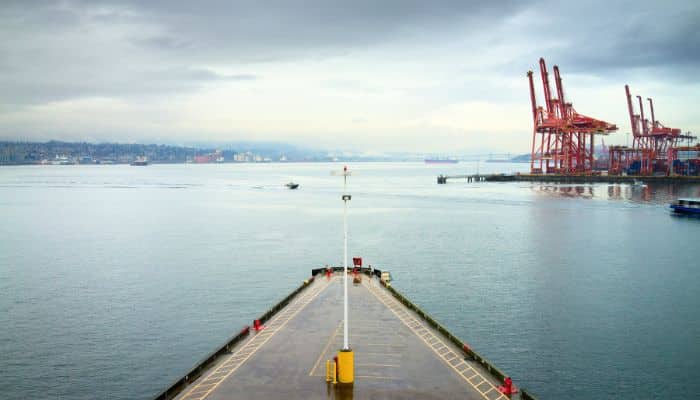
It is the country’s maritime trade gateway to 170 nations. It generates 115,300 jobs, $7 billion in wages, and $11.9 billion in GDP across Canada.
Vancouver Port has rail connections and direct access to key shipping routes, making it a principal gateway to Asia-Pacific trade.
2. Port of Montreal
Montreal is the largest port in Eastern Canada, handling all kinds of cargo and operating in several industries. It is a major cruise and transhipment point on the St Lawrence River in Montreal, Quebec. Although 1600 km inland from the Atlantic Ocean, it offers the shortest route between Europe and the Mediterranean region with the North American Midwest.
The port handled 36 million tonnes of cargo in 2022, a 5.8% increase from 2021. The container sector also rose slightly, with a growth of 1.2%, with 14.4 million tonnes handled and over 1.7 million TEUs.
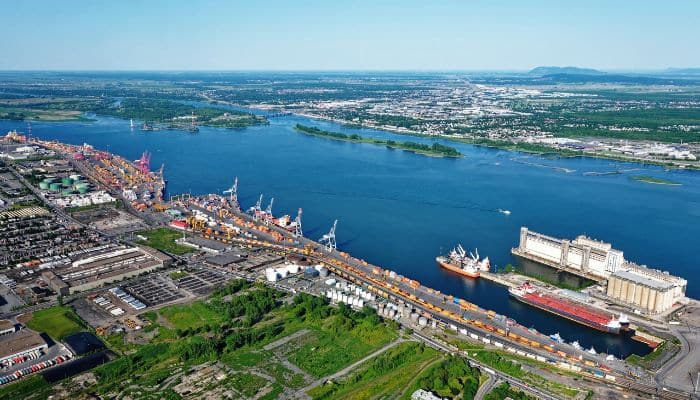
It is a diversified facility and directly connected to more than 140 nations which is why it is also referred to as the economic engine of Greater Montreal.
It has 23 terminals and over 100 km of rail tracks. The port handles 2000 ships per year, 60 to 80 trains a week, and 2500 trucks every 24 hours and has an efficient logistics ecosystem that handles around 6300 businesses.
Cruises are also welcome, and in 2022 about 45 international vessels called at the port, a preferred cruise destination.
3. Port of Prince Rupert
The nearest North American West Coast Port to Asia, Prince Rupert, is 500 nm closer than other ports in the Pacific Northwest, saving around 60 hours of sailing time.
It has the deepest harbour in North America, remains ice-free throughout the year and can accommodate the biggest ships, thanks to its main channel, which is 35 m deep, while its berths are 17 to 18 m deep.
The Port Authority announced that the port handled 24.6 million tonnes of cargo in 2022, a 2% decrease from 25.1 million tonnes in 2021. Prince Rupert was the continent’s first purpose-built ship-to-rail container terminal and continues to please its clients with its efficient services.
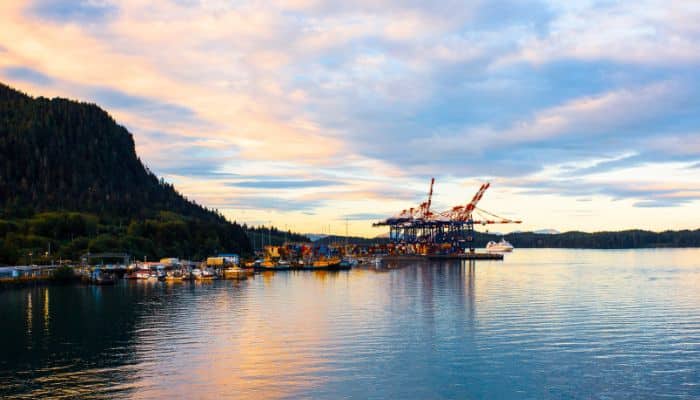
Th port’s Fairview Terminal handled 1.8 million TEUs in 2022. The grain terminal is the largest such facility on the west coast, dealing mainly with wheat, barley and canola procured from the prairies of Canada. It can export up to 7 million tonnes annually.
Trigon Pacific Terminals loads metallurgical coal, thermal coal, and petroleum coke at a rate of 9,000 tonnes per hour, with an annual shipping capacity of 18 million tonnes.
Westview Wood Pellet Terminal opened in 2014 with an annual export capacity of 1.25 million tonnes of wood pellets.
4. Port of Halifax
Located in Halifax, Nova Scotia, the Port of Halifax is the eastern maritime gateway to Canada, handling more than 19 million tonnes of cargo annually. It welcomes over 1500 ships, creates 13,000 jobs and has an economic impact of $ 2 billion.
It is also among the top 4 container ports in Canada. It crossed the 600,000 TEU annual container throughput mark in 2022, the first time in its history, by handling 601,700 TEUs in 2022 through its two modern container terminals, capable of accommodating ships with carrying capacities of over 16,000 TEUs.
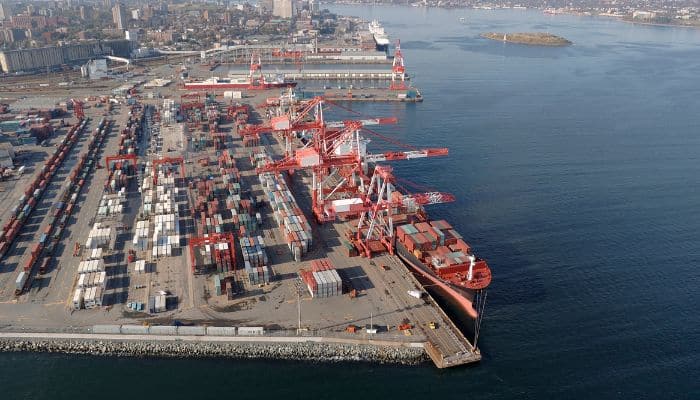
It is a well-sheltered, all-weather port with many berths and transit sheds. The world’s largest shipping lines call Halifax, and the port is linked to 150 nations. It is a beautiful seaport and a premier arts and cultural destination for locals and tourists.
The port harbour also receives cruise ships and has an oil refinery, shipyards with dry docks, graving docks, marine slips etc.
Major exports of Halifax comprise grains, lumber, gypsum, general cargo and containers. The port receives rubber, crude oil, automobiles, and project cargo shipments like wind turbine parts and other equipment.
5. Port of Saint John
Port of Saint John covers 120 hectares of land and 3900 m of the waterfront area of Saint John Harbour. It lies at the mouth of the Saint John River in New Brunswick, Canada. It has cargo handling facilities on both sides of the river and is known for its extreme tidal range and strong river currents.
Saint John is an ice-free deep water port with modern and specialised facilities. Major exports include forest products, refined oil products, grains, agricultural goods, flour, metals in ingot, salt and potash.
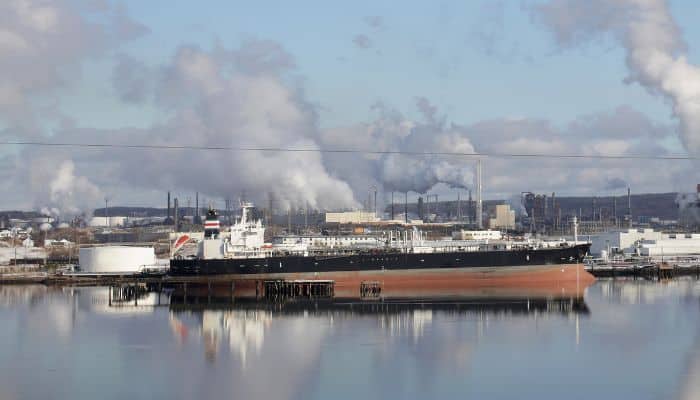
The port has 21 berths with a total docking area of 5000 metres. It also has several private facilities, such as the Courtenay Bay terminal, which is used to ship refined oil products from the Irving Oil Refinery and the Canaport Terminal, mainly dealing with LNG.
The port has a 70-acre container terminal linked to a major highway system, three on-dock warehouses and 480 reefer plugs.
2022 was a record year for Port Saint John as it handled over 100,000 TEUs for the first time in its history. The growth is quite appreciable amid a $205 million modernisation project.
6. Port of Quebec
Quebec Port lies on the St Lawrence River, about 750 nautical miles from the Atlantic Ocean. It is a true continental gateway that maintains business relationships with 50 countries.
Its popularity can be accorded to its strategic location, which offers the shortest maritime route between Europe and the Great Lakes.
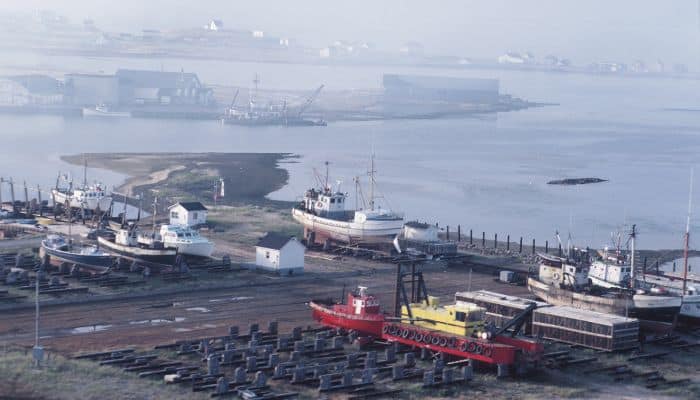
It has 14 terminals and the diversified facilities are situated in 4 port sectors, namely the Estuary, Anse au Foulon, Beauport and South Shore.
It also has St Romuald liquid bulk terminal and facilities for handling mineral concentrates, general cargo, coal, chemicals, grains, petroleum, granite, crude oil and other items ranging from dairy to newsprint.
It also provides extensive ship repair and bunkering services. Around 1500 ships, 30 million tonnes of cargo and 113,000 passengers are handled annually. Hence, it contributes to the sectors pivotal to foreign trade.
The port has also generated 13,000 jobs and caters to 103 million consumers.
7. Port of Port Cartier
It is a principal Canadian port situated in Quebec on the northern coast of the St. Lawrence River at the entrance to the Gulf Of Lawrence.
The port’s two terminals specialise in handling different types of cargo. The Multi-User Terminal handles bulk and general cargo, such as iron ores, forest products and grains.
The ArcelorMittal Terminal is used to export iron ore pellets.
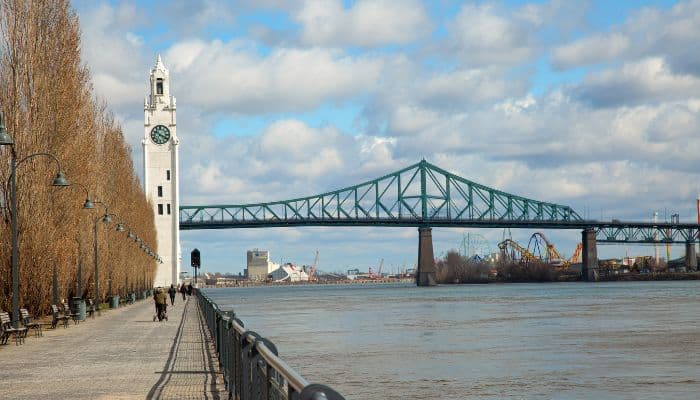
The port is mainly known for iron ore exports. It is one of the biggest iron ore export ports in the North American Continent since it is a critical gateway for iron ore produced in Quebec and Labrador.
It also has other facilities like a deepwater harbour with a 16 m draft and a 400 m wharf with four berths. It has 15,000 m2 of outside storage area and rail and road connections to major markets in North America.
Approximately 500 ships and 16,000,000 tonnes of cargo are handled annually.
8. Port of Sydney
Port of Sydney is a deepwater facility in Sydney, Nova Scotia, Canada, on the east coast of Cape Breton Island. It is one of the busiest ports in Atlantic Canada and contributes significantly to the local and regional economy.
It has several facilities like the Marine Terminal, the Syd-Port Industrial Park, Sydney Steel Corporation Wharves and the International Coal Wharf.
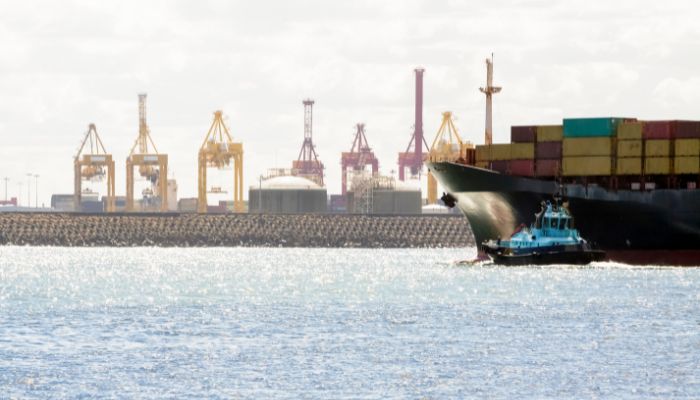
The Marine Terminal deals with containers, bulk and breakbulk cargo, and project cargo and the Novaporte Terminal handles mainly containerised cargo. The Port of Sydney also deals with seafood, forestry products and coal.
The port has a harbour with a 14 m depth and a 640 m long wharf with three berths.
About 200 vessels visit the port every year. It also handles 7,500,000 tonnes of cargo every year.
9. Port of Toronto
Toronto is a main inland port in Toronto, Ontario, Canada. It lies on the northwestern shore of Lake Ontario and is one of the biggest freshwater ports in the country, playing a significant role in the nation’s shipping sector and serving the global markets.
It covers 20 hectares and has seven berths, a 14,000 m2 marine terminal and a 100,000 m2 container terminal equipped with heated storage and a paved yard.
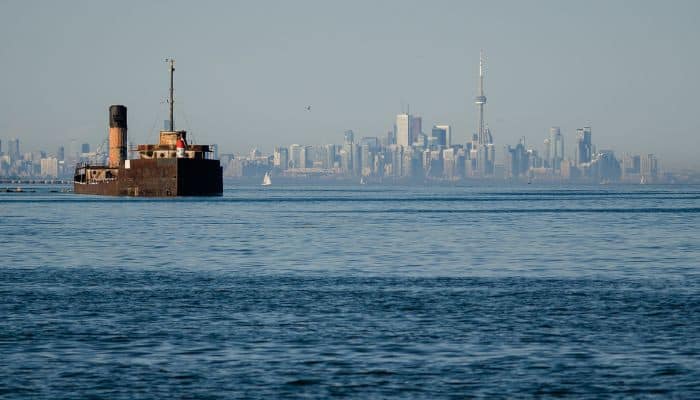
It has two main terminals, one which is the Cruise Ship Terminal and the other is the General Cargo Terminal. The latter deals with many commodities like bulk, breakbulk, steel, project cargo, sugar, salt, aggregates, asphalts etc.
Port of Toronto has a 10 m deep harbour and a 500 m long wharf. One of its main advantages is its location in the heart of the Greater Toronto Area, one of the largest metropolitan areas in the country.
10. Port of Hamilton
The Port of Hamilton is the biggest port in Ontario and the western maritime gateway to the Greater Toronto-Hamilton Area. It is a natural harbour linked to 2 Great Lakes Shipping routes, the Welland Canal entrance and the St Lawrence River, 151 nm from the Hamilton Harbour.
The port is vital for the leading industries in the region as it facilitates trade flow and propels domestic supply chains.
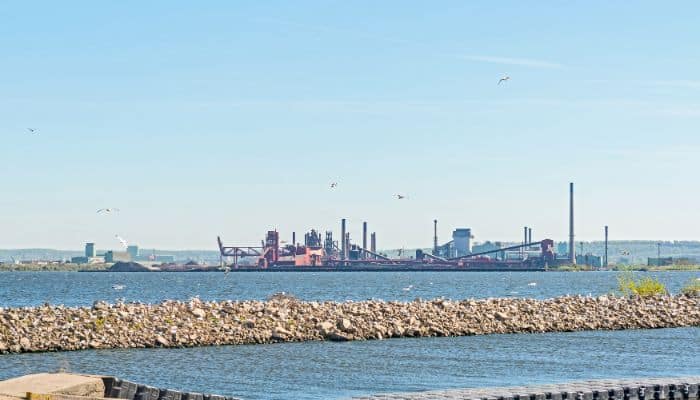
It handles around 10 million tonnes of cargo annually with a value of $ 2 billion. It is visited by 650 ships. The 255 hectares port has generated over 2000 jobs.
The port offers 11,000 metres of berthing space as well. It has dedicated berths for handling raw materials like coal, iron ore, steel, salt, grains, sand, liquid fertilisers and jet fuel.
Approximately 700 ships and over 12,000,000 tonnes of cargo are handled annually.
You Might Also Like To Read-
- 10 Major Ports In The Caribbean
- Top 10 Largest And Busiest Container Ports In The United States
- 10 Major Ports Of Scotland
- 20 Largest Container Shipping Companies In The World In 2023
- 10 Major Adriatic Seaports
Disclaimer :
The information contained in this website is for general information purposes only. While we endeavour to keep the information up to date and correct, we make no representations or warranties of any kind, express or implied, about the completeness, accuracy, reliability, suitability or availability with respect to the website or the information, products, services, or related graphics contained on the website for any purpose. Any reliance you place on such information is therefore strictly at your own risk.
In no event will we be liable for any loss or damage including without limitation, indirect or consequential loss or damage, or any loss or damage whatsoever arising from loss of data or profits arising out of, or in connection with, the use of this website.
Do you have info to share with us ? Suggest a correction
Disclaimer :
The information contained in this website is for general information purposes only. While we endeavour to keep the information up to date and correct, we make no representations or warranties of any kind, express or implied, about the completeness, accuracy, reliability, suitability or availability with respect to the website or the information, products, services, or related graphics contained on the website for any purpose. Any reliance you place on such information is therefore strictly at your own risk.
In no event will we be liable for any loss or damage including without limitation, indirect or consequential loss or damage, or any loss or damage whatsoever arising from loss of data or profits arising out of, or in connection with, the use of this website.

About Author
Zahra is an alumna of Miranda House, University of Delhi. She is an avid writer, possessing immaculate research and editing skills. Author of several academic papers, she has also worked as a freelance writer, producing many technical, creative and marketing pieces. A true aesthete at heart, she loves books a little more than anything else.
Latest Maritime Knowledge Articles You Would Like:
Subscribe To Our Newsletters
By subscribing, you agree to our Privacy Policy and may receive occasional deal communications; you can unsubscribe anytime.















